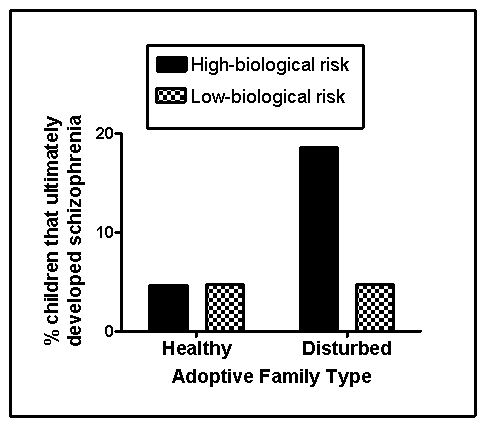Use the following to answer questions
Scenario II
The following scenario presents fabricated data consistent with the results of the following study:
Tienari,P. ,Wynne,L.C. ,Sorri,A. ,Lahti,I. ,Läksy,K. ,Moring,J. ,& ...Wahlberg,K.(2004) .Genotype-environment interaction in schizophrenia-spectrum disorder: Long-term follow-up study of Finnish adoptees.The British Journal of Psychiatry,184(3) ,216-222.doi:10.1192/bjp.184.3.216
Schizophrenia affects approximately 1% of the general population and is characterized by the profound disruption of basic psychological processes;a distorted perception of reality;altered or blunted emotional affect;and disturbances in thought,motivation,and behavior.The symptoms of schizophrenia are varied and are typically classified as either positive or negative.Positive symptoms of schizophrenia refer to thoughts and behaviors typically not observed in those without the disease and can include things like delusions (patently false beliefs) ,hallucinations (false perceptual experiences) ,and disorganized speech.Negative symptoms of schizophrenia are deficits or disruptions in normal behaviors,such as social withdrawal.Cognitive deficits in executive functioning,attention span,and working memory may also be observed.
The symptoms of schizophrenia usually begin in late adolescence and the disease has a strong genetic component.Over the years,a number of biological factors have been linked to schizophrenia,although none alone adequately accounts for the disorder.One such example is the dopamine hypothesis,which states that schizophrenia is related to an excess in dopamine activity.Another theory points to enlarged brain ventricles and progressive cortex tissue loss as predictive of schizophrenia.Although only a minority of persons with schizophrenia have enlarged ventricles,this structural anomaly can appear in those without the disease,and dopamine antagonists may also produce this effect.
Although research into the environmental determinants of schizophrenia has focused largely on the prenatal environment,psychological and social factors also contribute.Tienari and colleagues (2004) compared the risk of developing schizophrenia in children adopted into healthy versus disturbed families,the latter characterized by extreme conflict,volatile relationships,and communication deficits.Some of these children under investigation were identified as at-risk genetically for schizophrenia because their biological mothers were schizophrenic.The remainder were classified at low risk.The investigators utilized a longitudinal design and obtained the diagnostic status of the children with respect to schizophrenia when they reached young adulthood.Fabricated results consistent with this study are shown in Figure 15.2
Figure 15.2 
-(Scenario II) The dopamine hypothesis of schizophrenia was developed in large part due to research on the effects of psychoactive drugs in the brain.Which statement does that research NOT support?
Definitions:
United Nations Organization
An international organization founded in 1945 to promote peace, security, and cooperation among countries worldwide.
Allies
Refers to countries or entities that cooperate militarily or politically during a conflict. Usually refers to the Allied powers in World War I or World War II.
Tehran Conference
A meeting during World War II, in 1943, between leaders of the United States, the United Kingdom, and the Soviet Union to discuss war strategy.
Operation Overlord
The code name for the Battle of Normandy, the Allied operation that launched the successful invasion of Nazi-occupied Europe during World War II.
Q4: _ is often rated the most commonly
Q5: Type A personalities are at a(n)_ risk
Q11: (Scenario I).The final two stages of GAS
Q48: Which characteristic is NOT a diagnostic sign
Q51: Panic attacks must be accompanied by fear
Q52: The symptoms of a panic attack can
Q92: Person-centered therapists use a variety of exercises
Q127: What is the mental disorder in which
Q151: Gestalt therapists would be LEAST likely to
Q210: Who is/are the client(s)in family therapy?<br>A)the parent(s)<br>B)the